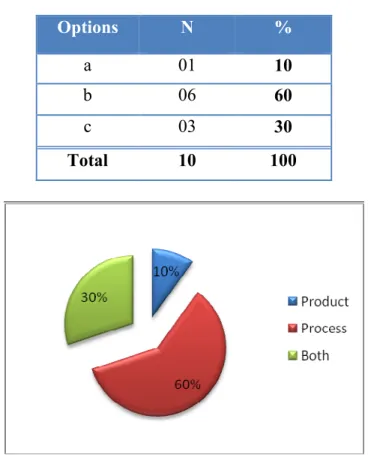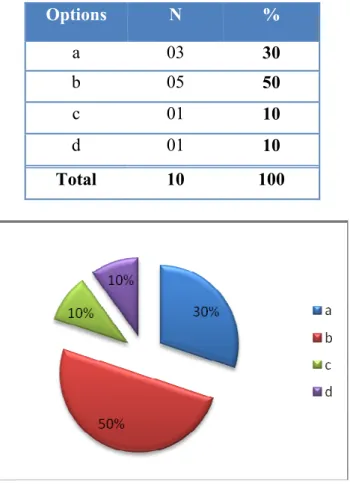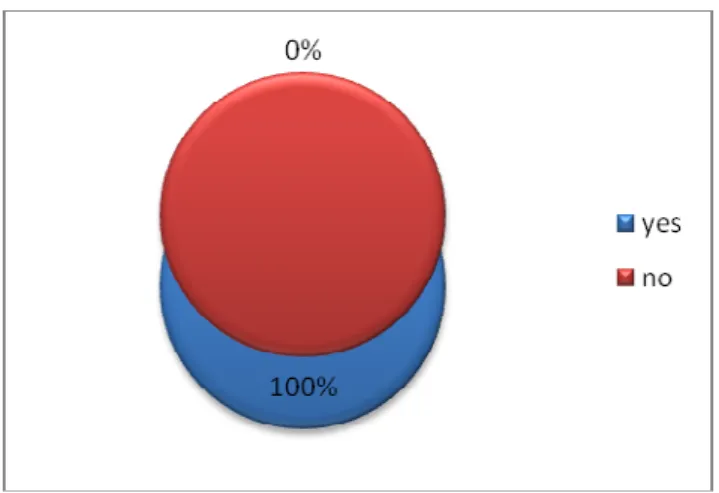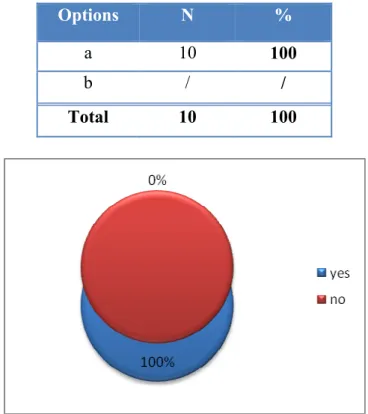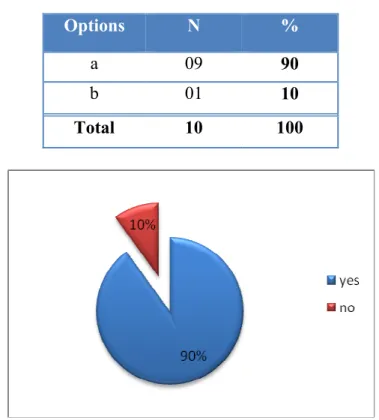Developping the writing skill through increasing learners' awareness of the writing process
Texte intégral
(2) DEDICATION. To the most precious people to my heart; to the ones who gave birth and meaning to my life, to the persons who gave me strength and hope:. To my dear mother and beloved father I dedicate this work.. To my brothers and sisters. To all my family and friends. To all those who prayed for me and besought God to help me. I.
(3) ACKNOWLEDGMENTS. This dissertation could not have been completed without the help of my teacher and supervisor Professor Ahmed Moumene to whom I would express my sincere thanks. I am grateful for his encouragement, kindness, patience and insightful advice throughout the completion of this work. In addition, I am thankful to my teachers at the department of English, namely Miss Babaa, Mr. Azil, Dr. Hamada, Dr. Labed and Dr. Nemouchi for their invaluable help and support. I am utterly grateful to the examining member of the jury, Professor Hacene Saadi for reading this work at a particularly difficult time of the year and for his priceless comments and observations that will surely help me enormously to polish this work. I am likewise immensely grateful to all those who have taught and trained me at Mentouri University. I would like to give special thanks to my friends and mates who encouraged and helped me. I will not forget, of course, to express my gratitude to all the teachers and students who filled in the questionnaires.. II.
(4) ABSTRACT. Writing in a foreign language is one of the most challenging and complex tasks for language learners. It is a difficult skill that requires considerable effort and practice on the learners’ part to reach an acceptable level of writing. Due to the complexity of this skill, many students find it very difficult to produce an adequate piece of writing. In this research work, we aim to make our students aware about the fact that the development of the writing skill involves dealing with writing as a process that entails different stages and not as a product of accurate use of grammar and vocabulary. Students should be made aware of the writing process through the intensive practice of writing which leads to the effective use of the writing techniques that allow them to decide about what to write, how to write, and how to evaluate what they write. Thus, making students aware of the different processes of writing will help them to overcome the difficulties they face when they write and to produce well written texts. It is by the means of two questionnaires devised to both teachers and students from the Department of Languages at Mentouri University-Constantine that we investigated our hypothesis. The findings gathered in this study confirmed the set hypothesis in that the problems students face in writing can be avoided, and effective production can be achieved if they are made aware of the importance of the writing process and the stages it entails.. III.
(5) LIST OF ABBREVIATIONS. EFL:. English as a Foreign language. ESL:. English as a Second Language. FL:. Foreign Language. L1:. First Language/Mother Tongue. L2:. Second Language. N:. Number of Teachers/Students. IV.
(6) LIST OF FIGURES. Figure 1.1: A Sequence of Ideas. Murray and Hughes…........................................................12 Figure 1.2: Model Based Approach. White…...…………………………………….......…...20 Figure 2.1: Process of Writing. Harmer…...………………………………………………...25 Figure 2.2: Process Wheel. Harmer…...……………………………………………………..25 Figure 3.1: Years of Teaching English………………………………………………………38 Figure 3.2: Years of Teaching “Written Expression”………………………………………..39 Figure 3.3: Teachers Opinions about the Time Given to Writing…………………………...40 Figure 4.4: “Written Expression” Programme Sufficiency in Improving Writing…………..41 Figure 3.5: Approaches Used by Teachers in Writing……………………………………….42 Figure 3.6: The Most Difficult Stage for Students in the Writing Process…………………..44 Figure 3.7: Teachers Helping Students When they Write…………………………………...46 Figure 3.8: The Importance of Awareness about the Process in Writing……………………47 Figure 3.9: Proceeding through the Writing Steps for Better Compositions………………...48 Figure 3.10: Teachers Asking Students to Proceed Through All the Writing Steps………...49 Figure 3.11: Students Following All the Writing Steps……………………………………..50 Figure 3.12: Students Attitudes towards the Module of “Written Expression”……………..56 Figure 3.13: Students’ Opinions about the Time Given to “Written Expression”….………..57 Figure 3.14: What Students Do after Reading the Topic they are Supposed to Write about………………………………………………………………………………………….59 Figure 3.15: The Most Difficult Step in the Writing Process………………………………..61 Figure 3.16: What Students do when they Write?...................................................................62 Figure 3.17: Students Awareness about the Writing Process………………………………..63 Figure 3.18: Students’ Proceeding through all the Writing Steps…………………………...65 Figure 3.19: Following the Writing Steps for Better Compositions…………………………66 Figure 3.20: Teachers Asking Students to Follow the Writing Steps………………………..67. V.
(7) LIST OF TABLES. Table 3.1: Years of Teaching English……………………………………………………….38 Table 3.2: Years of Teaching “Written Expression”………………………………………...39 Table 3.3: Teachers Opinions about the Time Given to Writing….…………………………40 Table 3.4: “Written Expression” Programme Sufficiency in Improving Writing …………..41 Table 3.5: Approaches Used by Teachers in Writing………………………………………..42 Table 3.6: The Most Difficult Stage for Students in the Writing Process……………….......44 Table 3.7: Teachers Helping Students When they Write…………………………………….45 Table 3.8: Aspects Teachers Help Students Editing…………………………………………46 Table 3.9: The Importance of Awareness about the Process in Writing…………………….47 Table 3.10: Proceeding through the Writing Steps for Better Compositions………………..48 Table 3.11: Teachers Asking Students to Proceed Through All the Writing Steps………….49 Table 3.12: Students Following All the Writing Steps……...……………………………….50 Table 3.13: Stages Students Proceed Through………………………………………………51 Table 3.14: Students Attitudes towards the Module of “Written Expression”………………56 Table 3.15: Students’ Opinions about the Time Given to “Written Expression”……………57 Table 3.16: What Students Do after Reading the Topic they are Supposed to Write about……………………………………………………………………….………………….59 Table 3.17: Most Important Components in Writing………………………………………..60 Table 3.18: The Most Difficult Step in the Writing Process………………………………...60 Table 3.19: Changes Students make when Re-reading………………………………………61 Table 3.20: What Students do when they Write?....................................................................62 Table 3.21: Students Awareness about the Writing Process…………………………….......63 Table 3.22: Students’ Familiarity with the Writing Stages………………………………….64 Table 3.23: Students’ Proceeding through all the Writing Steps………………….…………65 Table 3.24: Following the Writing Steps for Better Compositions………………………….66 Table 3.25: Teachers Asking Students to Follow the Writing Steps……...……...………….67. VI.
(8) CONTENTS. INTRODUCTION:………………………………………………………………………….01 Introduction…………………………………………………………………………..……….02 1. Statement of the Problem………………………………………………………………….02 2. Aim of the Study……………………………………………………………………….…..03 3. Research Questions and Hypothesis…………....……………………………….…………03 4. Tools of Research………………………………………………………………………….04 5. Structure of the Study………………………………………………………….…………..05. CHAPETR ONE: THE WRITING SKILL.........................................................................06 Introduction………………………………………………………....………………………...07 1.1. Nature of Writing…………………………………………………………………….......07 1.2. Reasons for Teaching Writing..…………………………………………………….……09 1.3. Effective Writing…………………………………………………………………….......09 1.3.1- Organization………………………………………………………………………10 1.3.2- Clarity……………………………………………………………………………..11 1.3.3- Coherence……………………………………………….………………………...12 1.3.4- Word Choice………………………………………………………………….......13 1.3.5- Mechanics…………………………………………………………………………13 1.4. Writing and Other Language Skills………………………………………………….......14 1.4.1- Four Language Skills Working Together………………………..……………….14 1.4.2- Writing and Speaking…………………………………………………………….15 1.4.3- Writing and Reading…………………………………………………………........16 1.5. Approaches to Teaching Writing………………………………………………………..18. VII.
(9) 1.5.1- The Controlled-to-Free Approach………………………….……………………..18 1.5.2- The Free-Writing Approach………………………………………………………19 1.5.3- The Product-Oriented Approach…………………………...….………………….20 1.5.4- The Process-Oriented Approach………………………………………………….20 1.5.5- The Genre Approach………………………………………………………….......21 Conclusion……………………………………………………………………………………22. CHAPTER TWO: THE PROCESS APPROACH AS AWARENESS RAISING…........23 Introduction…………………………………………………………………………………...24 2.1. The Writing Process……………………………………………………………………..24 2.2. The Process Approach……………………………………………………………….......26 2.3. Models of the Writing Process…………………………………………………………..27 2.3.1- The Flower and Hayes Model…………………………………………………….27 2.3.2- The Bereiter and Scardamalia Model…………………………………………….28 2.4. Stages of the Writing Process……………………………………………………………29 2.4.1- Prewriting…………………………………………………………………………29 2.4.2- Drafting………………………………………………………………………........30 2.4.3- Reviewing………………………………….………………………………….......31 2.4.4- Editing…………………………………………………………………………….32 2.5. Awareness…………………….………………………………………………………….33 2.5.1- Awareness Defined………………………………………………………………..33 2.5.2- Types of Language Awareness…….……………………………………………..33 2.5.3- Awareness Raising………………………………………………………………..34 Conclusion ……………………………………………………………………………………35. VIII.
(10) CHAPTER THREE: DEVELOPING THE WRITING SKILL THROUGH INCREASING AWARENESS OF THE WRITING PROCESS…………………….......36 3.1. The Teachers Questionnaire……………………………………………………………..36 Introduction………………………………………………………………………….......37 3.1.1. Administration of the Questionnaire………………………………………….......37 3.1.2. Description of the Questionnaire………………………………………………….37 3.1.3. Analysis of the Questionnaire…………………………………………………….38 3.2.4. Discussion of the Results of the Questionnaire…………………………………..51 Conclusion…………………….…………………………………………………………52 3.2. The Students Questionnaire………………………………………………………….......54 Introduction………………………………………………………………………….......55 3.2.1. Administration of the Questionnaire………………………………………….......55 3.2.2. Description of the Questionnaire………………………………………………….55 3.2.3. Analysis of the Questionnaire…………………………………………………….56 3.2.4. Discussion of the Results of the Questionnaire……………………………….......67 Conclusion ...…………………………………………………………………………….68. CONCLUSION.......................................................................................................................70 REFERENCES………………………………………………………………………...........73 APPENDICES ...……………………………………………………………………………79. IX.
(11) INTRODUCTION.
(12) INTRODUCTION. Introduction ………………………………………………………………………….….........02 1. Statement of the Problem ……………...……………………………………………..........02 2. Aim of the Study …………………………………………………………………….…….03 3. Research Questions and Hypothesis …………………………………………………........03 4. Tools of Research ………………………………………...……………………….…........04 5. Structure of the Study ……………………………………………………………………..05. 1.
(13) Introduction Writing in a foreign language is one of the most challenging skills for almost all learners. Developing the writing skill is thought to be highly complex if not the most complex in comparison to listening, speaking and reading. What makes writing a very troublesome task for EFL learners is the fact that it requires some criteria of acceptability relative to different aspects of writing which include content, organization, vocabulary, language use, spelling, punctuation and accurate capitalization and paragraphing. In addition to the former criteria of acceptability, and in order to make an acceptable piece of writing, learners should pass through different stages of writing that enable them to proceed from the blank sheet of paper to the final version of writing. This progression is widely known as “process”. Probably, the model of writing is commonly known by EFL learners as the original planning-writing-reviewing framework. During planning, for example, learners need to be able to generate, organize and adapt information to the specificities of a given task activities. The drafting stage as another example is the ‘physical act of writing’; it is when the writer actually writes following the flow of his ideas. And as a third example, the revising stage which is the stage during which writers correct mechanical errors and realize substantial changes in their writing.. 1. Statement of the Problem Due to the complexity of the writing skill, a great majority of FL learners find it difficult to master all the mechanics of writing and to use them appropriately; therefore they do not produce acceptable compositions. One of the factors that seems to be obstructing learners from achieving good performance in writing is that they neglect the process in which writing should be carried out. Classroom observation and interviewing allowed us to say that most of the learners when writing about a certain topic, allow very little time to planning and tend to. 2.
(14) be more occupied with mechanics, particularly spelling, instead of organization and arrangement which they seem to consider of secondary importance, if they consider it at all. The question is that many learners seem to achieve well when it comes to producing short sentences and paragraphs; but when it comes to writing compositions, they make too many mistakes and erroneous forms. Learners lose their ability to write short and correct sentences, they tend to say everything at a time. They seem to ignore their knowledge about the techniques of writing, especially planning and revising; the longer their sentences are, the more mistakes they contain, and less meaning is clearly expressed.. 2. Aim of the Study Since many learners have difficulties to manage writing coherently and accurately in the target language, it is our belief that the mastery of writing requires an understanding of how the writing process works, by emphasizing not only the product, but also the different stages the learner goes through as a process. In this dissertation, we aim to make our students aware of the development of the writing skill and the stages it involves as a process not as a product of accurate use of grammar, syntax and vocabulary. They should be made aware through intensive practice of writing which leads further to the effective use of the writing techniques that allow them to decide about what to write, how to write, and how to evaluate what they have written. Thus, making students aware of the different processes of writing will help them to overcome the difficulties they face when they write, and therefore produce well written-texts.. 3. Research Questions and Hypothesis Writing is not a linear but a recursive process, where students plan, revise and redraft what they produce. It is through these different stages that the student develops his idea on the 3.
(15) topic and the text at the same time. Writing is also considered a difficult and challenging aspect to be learned in a foreign language. For this reason, we have to put the following research questions: 1- What lies behind the difficulty of the writing skill? 2- Are students aware of the criteria that characterize a successful, good piece of writing? 3- To what extent the adoption of the process approach and the steps it entails are important in diminishing or preventing students’ problems in writing? On the basis of these questions, the following hypothesis is put forward: If learners are made aware of the process of writing, how to proceed through the different stages of writing successfully, they would write more easily and produce more effective compositions.. 4. Tools of Research Concerning data collection, we would administer two main questionnaires; one to teachers, and the other to second-year learners. The teachers’ questionnaire would be directed to those who have been teaching writing for a considerably long period of time. The purpose behind this is to make sure that their suggestions are the product of a continuous interacting with language learners during many years of evaluation and observation of learners’ needs and requirements. Since it is not possible to deal with all the second year students (because of time constraints), we have to take a representative sample (we will explain the randomization process later on) to be given the questionnaire. The aim of the learners’ questionnaire is to gauge the students’ level of awareness of the writing process and the writing techniques underlying this process.. 4.
(16) After collecting the required data for this research, we would analyze them quantitatively and qualitatively to understand the issue under study; i.e., the importance of understanding the stages of writing which, we believe will smooth the progress of developing the writing skill.. 5. Structure of the Study The present research will be basically divided into three main chapters. Chapters One and Two will be devoted to the literature review and Chapter Three will be about the analysis of both quantitative and qualitative responses and the results obtained from the teachers and learners questionnaires. The first chapter will be devoted to the skill of writing. It will comprise a description of writing; what writing is about; the criteria that make for writing a good paragraph/essay; and the reasons for teaching writing. We will also try to shed light on the relationship between writing and other language skills including speaking and reading. In this chapter, we will also try to explore the resources of the writing skill and the different writing approaches. In the second chapter of the literature review, we will try to discuss the subject of our research according to the different theoretical standpoints. We will consecrate a good deal of our discussion for identifying learners’ capacities of understanding the writing techniques and how they can best develop them. We will concentrate on the main three techniques of the process approach, namely prewriting, drafting and revising, and the ways of raising learners’ awareness about their application in developing an effective piece of writing. Finally, the last chapter of the proposed research will be mainly an investigation of the degree of second-year LMD students’ commitment to the process of writing and its effects on their achievement in writing.. 5.
(17) CHAPTER ONE The Writing Skill.
(18) CHAPTER ONE. THE WRITING SKILL. Introduction…………………………………………………………………………………...07 1.1. Nature of Writing………………………………………………………………………...07 1.2. Reasons for Teaching Writing..…………………………………………………….…….09 1.3. Effective Writing……………………………………………………………………........09 1.3.1- Organization…………………...………………………………………………….10 1.3.2- Clarity……………………………………………………………………………..11 1.3.3- Coherence…………………………………………………………………………12 1.3.4- Word Choice…………………………………………………………………........13 1.3.5- Mechanics…………………………………………………………………………13 1.4. Writing and Other Language Skills………………………………………………….......14 1.4.1- Four Language Skills Working Together……………………………………..…..14 1.4.2- Writing and Speaking……………………………………………………………..15 1.4.3- Writing and Reading………………………………………………………............16 1.5. Approaches to Teaching Writing………………………………………………...………18 1.5.1- The Controlled-to-Free Approach………………………………………...………18 1.5.2- The Free-Writing Approach…………………………………………..…………..19 1.5.3- The Product-Oriented Approach………………………………………..………...20 1.5.4- The Process-Oriented Approach…………………………………..………………20 1.5.5- The Genre Approach……………………………………………..………….........21 Conclusion ……...………………………………………………..…………………………..22. 6.
(19) Introduction Learning a foreign language requires learning the four skills of this language. Language teachers usually follow a certain order; beginning with listening, speaking, reading and then writing. The reason behind leaving writing at the end is that it is viewed as the most important, most difficult and most sophisticated one compared with the other language skills. Writing, therefore, is a fundamental skill in language learning; it is also a difficult skill that requires considerable effort and practice on the learner’s part to reach an acceptable level of writing. In this chapter, we will present the reader with the writing skill in general, including the different definitions, the criteria that make for producing an effective piece of writing, and the reasons for writing to be taught. It also deals with the writing skill and the other skills speaking and reading comparatively. It also explores the resources of the writing skill and the different writing approaches.. 1.1. Nature of Writing Writing is generally a group of letters or symbols written or marked on a surface as a means of communication (Collins, 2003). This definition suggests that writing is the activity of producing a piece of written language which is designed to be read. However, writing is more than being a matter of transcribing language into symbols. Just as speech is more than producing sounds, writing is much more than the production of graphic symbols; these symbols have to be arranged according to some conventions to form words, and to combine them to form sentences. A sequence of sentences, short or long, but coherent is an adequate means of communication. According to Collins and Gentner (1980: 62), the learner/writer should consider the four structural levels in writing starting with the word structure, sentence structure, paragraph structure, and overall text structure. Coordinating all these aspects is a staggering job that is definitely more than a simple activity of putting symbols together.. 7.
(20) In addition to the intricacy of structure, other psychological, linguistic and cognitive related issues interfere to make writing a complex activity for both native speakers and language learners. Byrne (1991: 4) explains that writing is a difficult activity because it is neither a natural nor a spontaneous activity and that “the problems related to writing are usually grouped under three headings which overlap to some extent: psychological, linguistic and cognitive.” Moreover, writing is directly linked to people’s roles in society. According to Tribble (1996: 12) to be deprived of the opportunity to learn how to write is “to be excluded from a wide range of social roles, including those which the majority of people in industrialized societies associate with power and prestige.” In the same direction goes Kress (1989; in Tribble, 1996), emphasizing that learning to write in not just a question of developing a set of mechanical ‘orthographic’ skills but it also involves learning a new set of cognitive and social relations. In terms of pedagogy, writing is a central element in the language teaching setting as students need to write down notes and to take written exams. Yet, over the years it has seemed that writing has been seen as only a support system for learning grammar and vocabulary rather than a skill in its own right. However, trainers and methodologists have looked again at writing in the foreign language classroom and acknowledged the importance of writing as a vital skill for speakers of a foreign language as much as for everyone using their first language (Harmer, 2004). So, the idea we draw from the previous definitions is that writing is the activity of being able to communicate with language through a graphic representation of ideas. It is also a difficult, sophisticated, prestigious social activity of communication and an important skill for language learners as well as native speakers.. 8.
(21) 1.2. Reasons for Teaching Writing Almost all human beings grow up speaking their first language (and sometimes second or third) as a matter of course. Spoken language, for a child/learner is acquired naturally as a result of being exposed to it, whereas the ability to write has to be consciously learned. Harmer (2004: 3) agrees that writing should be learned because it could not be naturally acquired like speaking, though, he provides more reasons to teach writing for EFL learners which include reinforcement, language development, learning style, and most importantly, writing as a skill in its own right. Harmer (1998: 79) illustrates the reasons for teaching writing as follows: •. Reinforcement: Some learners acquire languages in a purely oral/aural way, but most of them benefit greatly from seeing the language written down.. •. Language development: The mental activity learners go through in order to construct proper written texts is all part of the ongoing learning experience.. •. Learning style: For many learners, producing language in a slower way is something they appreciate. Writing provides time and ease for learners more than face-to-face communication does.. •. Writing as a skill: Learners need to know how to write essays, how to put written reports together and how the writing system operates (for example, in terms of conventions such as punctuation, paragraph construction) just as they need to know how to pronounce language appropriately.. 1.3. Effective Writing Writing in English within an academic context requires some criteria of acceptability relative to different aspects of writing which include organization, vocabulary, language use, punctuation, accurate capitalization and paragraphing. According to Starkey (2004), an. 9.
(22) effective piece of writing is the one that is organized, clear, and coherent, with accurate language and effective word choice.. 1.3.1- Organization In the process of writing, information should be presented to readers in a structured format; even short pieces of writing have regular, predictable patterns of organization. The striking advantage of organization is to help the reader to believe what you are saying, and to willingly. follow your lead. Starkey (2004: 2) states: By following [an organized method of writing], you will guide your reader from your first to last sentence. He or she will be able to see how the various points you make in your [piece of writing] work together and how they support your thesis.. Organization is usually decided upon through certain techniques that precede the actual act of writing. In other words, the writer decides about the organization of his written work before engaging into the physical act of writing through some prewriting techniques including mainly free-writing and brainstorming. The use of the prewriting techniques helps at making an effective plan that guarantees the organization of the written work because a plan is usually made after reading and classifying the notes gathered from the prewriting activity. According to Chelsa (2006), Creme and Lea (2008), and Galko (2002), free-writing and brainstorming are effective for shaping the learner’s thoughts allowing some time to make connection with the assigned subject noting everything and anything that comes to mind. The two preceding techniques are similar in that they are timed, and flowing exercises meant to elicit many thoughts and ideas on a given topic. However, free-writing requires putting whole sentences or phrases on paper whereas brainstorming involves creating a list that might contain various individual thoughts that make sense in a particular order.. 10.
(23) 1.3.2- Clarity The learner’s goal when writing in an academic context is to convey information, including the fact that he can write well (Starkey, 2004: 11). Clarity is an essential element of writing the learner should become skilled at in order to make his writing readable, and guarantee that those who read it understand exactly what he means to say. Murray and Hughes (2008: 86) emphasize the importance of clarity as a fundamental element in making one’s writing easy to be read and accessible. According to them, the key to achieve clarity is to make sentences short and to the point, the learner/writer should be relevant, make every word count, and try not to express more than one idea in each sentence. In order to achieve clarity in writing, according to Starkey (2004: 12-9), the learner should: •. Eliminate ambiguity by avoiding words or phrases that have more than one possible interpretation. The learner should focus on what he means and keep away from any language structure that could mislead the reader.. •. Use powerful, precise adjectives and adverbs. One way to accomplish clarity is to use powerful and specific adjectives and adverbs. The right modifiers (adjectives and adverbs) help out the learner to convey his message across in fewer, more accurate words. For example, Chihuahua can take the place of little dog; exhausted can take the place of really tired; and late can take the place of somewhat behind schedule.. •. Be concise, this means getting right to the point without unnecessary spinning around, worthless repetition or wordiness. Starkey (2004: 15) sees that: “wordiness is boring, and it takes up valuable time and space… there are two equally important approaches to more concise writing: eliminating unnecessary words and phrases, and using active (as opposed to passive) voice whenever possible.” Moreover, he provides two reasons for avoiding repetition of ideas and information in one’s writing: The first is that unnecessary repetition is a sign of sloppy writing. It is easy to say the same thing a number of times, varying it slightly each time. It is harder to say something well once, and continue writing about your next idea or example. Second, wordiness wastes valuable time and space. If you are 11.
(24) writing while the clock is ticking, or are limited to a number of words or pages, say it right the first time and move on. Starkey (2004: 17). 1.3.3- Coherence Coherence is an important element in any kind of writing. It is particularly crucial in academic writing, where success or failure may depend upon how clearly the learner has managed to communicate his ideas and points of argument to his reader. No matter how insightful or original those ideas may be, if he is not able to present them in a clear and logical way, their meaning and value is lost. Kane (2000) and Creme and Lea (2008) among others, agree that coherence has a great role in making a good piece of writing. According to them, coherence has to do with arranging and linking one’s ideas in a way that makes them most easily understood by the reader. Murray and Hughes (2008: 45) notice that a good writer is the one “who sticks his ideas together as links in a chain, each link connecting the one before it with the one after. If any links are missing, the connections become unclear and the argument structure breaks down.”. Figure.1.1: A Sequence of Ideas. (Murray and Hughes, 2008: 46). A piece of academic writing, as shown in figure.1.1, has a history in the sequence of building up its academic structure. The reader is only able to make sense of what he is reading at any particular point because it connects clearly with what has gone before, that is why the learner/writer should make that connection clear.. 12.
(25) 1.3.4- Word Choice The best way for the learner to accurately convey his ideas in writing is to choose the right words. Doing so ensures that the reader understands what the writer is really writing. According to Starkey (2004) and Kane (2000), there are two aspects the learner should consider while choosing the words to be used: denotation and connotation. Denotation is the basic or literal meaning of a word. Learners should make sure of the correctness of their words, because sometimes some confusion may stem from words that sound or look similar (but have very different meaning), words and usages that sound correct (but in fact are not considered standard English), or words that are misused so often that their usage is thought to be correct. Connotation "is a word’s implied meaning which involves emotions, cultural assumptions, and suggestions” (Starkey, 2004: 21). The learner should confirm that each used word denotes exactly what he intends to it, considering connotation requires the learner thinking beyond the dictionary, to what might be implied or inferred by his writing. According to what has been said before, both denotative and connotative meanings must be considered when making word choice. However, this is not all, the learner should also consider whether the used words might confuse or possibly offend his audience. This means avoiding informal language, clichés and slang words.. 1.3.5- Mechanics In composition, ‘mechanics’ refers to the appearance of words, to how they are spelled or arranged on paper. The fact that the first word of a paragraph is usually indented, for example, is a matter of mechanics (Kane, 2000: 15). Conventions of writing require that a sentence begins with a capital letter and ends with full-stop punctuation (period, question mark, or exclamation point). These types of conventions or mechanics are very significant in 13.
(26) putting together a good quality piece of writing because no matter how original are the learner’s ideas, if he cannot express them in a clear and accurate manner. Starkey (2004) addressed writing mechanics in terms of grammar, spelling, punctuation and capitalization. Grammar is a key element not only in writing, but in language as a system of communication in general. Having a good knowledge of the parts speech, the structures of the language and its rhetorical devices and knowing how to manipulate them in order to write comprehensively is what writing requires. Brooks and Penn (1970: 20) state: … For one thing, in writing, we must understand the structure of the language, what the parts of speech do, how the words relate to one another, what individual words mean, the rules of grammar and punctuation.. Capitalization and punctuation marks are integral parts of written english. Among other things, “they indicate pauses and sentence boundaries and also eliminate ambiguity. A well punctuated and capitalized piece of writing should make your work easier to read and understand and will therefore help it make a more favourable inpression on your readers” (Murray and Hughes 2008: 185). Similarly, spelling is one of the factors which need to be taken into account by students when dealing with writing, because it is an aspect many teachers in an EFL context focus on when evaluating students work. Correct spelling gives one’s work credibility. Not only will the reader know that one is educated, but also that he is careful about his work.. 1.4. Writing and Other Language Skills 1.4.1- Four Language Skills Working Together Writing is not an isolated skill. Four language skills work together to enhance the development of each other: speaking, listening, reading and writing. Listening and reading are the receptive skills (taking in information), and speaking and writing are the productive skills (giving out information). According to Johnson (2008), language skills enhance each other; 14.
(27) i.e. the development of individual language skills improves the development of others. For example, listening and hearing other people use language enhances one’s ability to speak, reading helps students become better writers, and writing helps in developing phonic knowledge and enhances reading fluency.. 1.4.2- Writing and Speaking Both writing and speaking are clearly productive activities in that they create language outcomes just as listening and reading are both passive activities. When it comes to communication, Kress (1989; in Tribble, 1996: 12) sees that speaking and writing are complementary skills and emphasizes that “the person who commands both the forms of writing and of speech is therefore constructed in a fundamentally different way from the person who commands the form of speech alone.” However, the physical act of speaking and writing are very different. What follows is a summary of some differences between writing and speaking as seen by Brown (1994): •. Performance: oral language is transitory and must be processed in real time, while written language is permanent and can be read and re-read as often one likes.. •. Production time: writers generally have more time to plan, review and revise their words before they are finalized, while speakers have a little or no time to do this.. •. Distance between the writer and the reader in both time and space eliminates much of the shared context that is present between speaker and listener in face to face contact and this necessitates greater explicitness from the part of the writer.. 15.
(28) •. Orthography in writing carries a limited amount of information compared to the richness of devices available to speakers to enhance a message (for example: stress, intonation, pitch, volume, pressing).. •. Complexity: written language tends to be characterized by longer clauses and more subordinators, while spoken language tends to have shorter clauses connected by coordinators, as well as more redundancy (repetition of nouns and verbs).. •. Formality: because of the social and cultural uses of which writing is ordinarily put, writing tends to be more formal than speaking.. •. Vocabulary: Written texts tend to contain a wider variety of words, and lower frequency words, than oral speech.. Harmer (2004: 7-10) makes the difference between writing and speaking in terms of time and space of communication, participants, process, organization, language, signs symbols and product. However, he sees that in some contexts, these differences between writing and speaking fade away. For example, the use of written language in text messaging and internet chatting seems to be more like speech than written discourse where speakers seem to be speaking while using written words. As another example, is the degree to which a formal speech follows the rules of writing in terms of structure, organization, and use of language; such types of speech seem to be more writing rather than speaking.. 1.4.3- Writing and Reading From a historical point of view, reading was more emphasized than writing in education. In Britain, for example, in the eighteenth and nineteenth centuries, reading took the primary attention in education before writing, and this is because as Foggart (1993; in Tribble, 1996: 16.
(29) 11) states: “it is desirable that the majority should read in the way they can be given instructions and can be educated into a particular ideology; writing on the other hand, assumes the giving of instructions and the formation of views about society.” In an industrialized society, reading is a survival skill which enables you to react to range of social demands (reading is a pervasive requirement: looking at an alarm clock, glancing at the news paper, or checking the departures board). Writing, in contrast, is a less necessary skill but one which can lead to more proactive roles. When looking at the nature of writing and reading, it seems that the two skills are separate in that reading is a passive activity and that writing is a productive one; still, these two language skills are complementary and can be closely developed. As it is seen by Johnson (2008: 7), the apparent relationship between the preceding skills is that reading helps students become better writers. Through reading, students have incidental contact with the rules of grammar, so they develop a sense for the structure of the language and grammar and increase their vocabulary. Therefore, Reading in the writing classroom is understood as the appropriate input for acquisition of writing skills because it is generally assumed “that reading passages will somehow function as primary models from which writing skills can be learned, or at least inferred” Eisterhold (1990: 88). The nature of this reading-writing link, though not well-defined is often thought to be like Krashen’s notion. Krashen (1984: in Eisterhold, 1990: 88) claims that the development of writing ability occurs via comprehensible input with a low affective filter. He theorizes that writing competence derives from large amounts of self-motivated reading for interest and/or pleasure. The evidence that there is an existing relationship between reading and writing is the results of the correlational study carried by Stotsky (1983) that came out with the following results: 17.
(30) 1- There are correlations between reading achievement and writing ability. Better writers tend to be better readers. 2- There are correlations between writing quality and reading experience. Better writers read more than poorer writers. 3- There seem to be correlations between reading ability and measures of syntactic complexity in writing. Better readers tend to produce more syntactically mature writing than poorer readers (ibid).. 1.5. Approaches to Teaching Writing In the early 1960’s, writing was a neglected skill; it was argued that language is most important in its spoken form and less important in the written one; and for this reason, writing was not given much attention. When writing was first included in teaching curricula, it was viewed as a simple reinforcement of “what students learned to say” (Rivers, 1968: 51). After the 1960’s, writing gained importance and was considered central in the language learning context. Its understanding and use became largely valued in every discipline, each of which requires a specific method of teaching. Consequently, a great number of approaches and methods of teaching have come out. Although none of these approaches can be considered as ideal, they have all proved to be successful in one period or another (Nemouchi, 2008).. 1.5.1- The Controlled-to-Free Approach In the 1950’s and 1960’s, when the audio-lingual approach prevailed, writing was taught only to reinforce speech where speech was considered primary. It was believed that the mastery of grammar rules would lead to the improvement of the spoken form of a foreign language, and this is the reason for allocating grammar teaching to writing. In this approach, 18.
(31) students are not supposed to create their own texts; the only writing learners do is to write grammar exercises (Leki, 1992). The controlled-to-free approach is sequential: students are first given sentence exercises, then paragraphs to copy or manipulate grammatically by changing questions to statements, present to past, or plural to singular. Only after having improved this type of highly controlled-writing can students move to free composition in which they can express their own ideas (ibid). Perhaps, one of the most outstanding attributes of the controlled-to-free approach is that it emphasizes accuracy rather than fluency or originality (Ghaith, 2002). It focuses on the structural aspect of the language and neglects its communicative aspect as Raimes (1983: 76) states: “this approach stresses three features: grammar, syntax and mechanics.”. 1.5.2- The Free-Writing Approach The free-writing approach is essentially based on the belief that when we write freely and frequently, we improve our ability in that language skill. Free writing means that the students write without teachers’ interference, and are encouraged to emphasize content and fluency first (Raimes, 1983). This approach stresses writing quantity rather than quality. Teachers who use this approach assign vast amounts of free writing on given topics with only minimal correction. The emphasis in this approach is on content and fluency rather than on accuracy and form (Ghaith, 2002). Once ideas are down on paper, according to Raimes (1983), grammatical accuracy, organization and the rest will gradually follow. Contrary to the controlled to free approach, the role of the teacher is limited to reading learners’ productions and sometimes making commands on the expressed ideas. In other words, pieces of writing should not be corrected, but possibly read aloud and the content commented upon.. 19.
(32) 1.5.3- The Product-Oriented Approach Broadly speaking, a product-oriented approach, as the title indicates, is concerned with the final result of the writing process. It is mainly based on activities which require from the learner to be engaged in imitating and transforming model texts. Indeed, the imitation of a model was seen as crucial. White (1998) sees the model based approach as follows:. Study the model. Manipulate elements. Produce a parallel text. Figure.1.2: Model Based Approach. (White 1998: 46). The model text is always taken as the starting point. It is studied and analyzed from all points of view: structures of grammar, content, sentences, organization, and rhetorical patterns. After manipulating these features, students are given a new topic and invited for a parallel writing task. The interest of such an approach is in the correct use of form. Naturally the role of the model is important in the sense that it leads students from a point of departure to an end with a task to replicate. The model then comes first and shows a competed text as well. “What the model does not demonstrate”, says white (1998: 6), “is how the original arrived at that particular product. In other words, it gives no indication of the process.”. 1.5.4- The Process-Oriented Approach This approach shifted the attention from the traditional view of looking at writing purely as a product to emphasize the process of writing. Students need to realize that what is first written down on paper is not the final product, it is only the beginning. The process approach depends on giving students time to work on what they want to write, going from pre-writing activities to the final draft. According to Nemouchi (2008), the major aim of this approach is to train students how to generate ideas for writing, plan these ideas, take into account the type 20.
(33) of audience, draft and redraft in order to produce a final written paper that is likely to communicate their ideas. The process approach according to many scholars may include identified stages of the writing process such as: pre-writing, writing and rewriting. When the first draft is created, it is refined into subsequent drafts with the assistance of peer or teacher conferencing (Murray, 1992). According to Gocsik (2007), in a process-oriented approach, the learner should ask a number of questions before plunging into the activity of writing "ranging from What do I write about? To Who is my audience? To How do I structure my essay? To What sort of language and voice should I use?" In order to shed more light on the process-oriented approach and reinforce the given definitions, we will quote Murray (1992: 16): The process-oriented approach refers to a teaching approach that focuses on the process a writer engages in when constructing meaning. This teaching approach concludes with editing as a final stage in text creation, rather than an initial one as a product-oriented approach. The process-oriented approach may include identified stages of the writing process such as: pre-writing, writing and re-writing. Once the rough draft has been created, it is polished into subsequent drafts with the assistance of peer and teacher conferencing.. 1.5.5- The Genre Approach The genre approach to teaching writing is mainly concerned, as the name indicates, on teaching particular genres that students need control of in order to succeed in particular situations. This might include a focus on the language and discourse features of the texts as well as the context in which the text is produced (Nemouchi, 2008: 92-3). The fundamental principle that underlies the genre-based approach is that language is functional; that is through language that we achieve certain goals. Moreover, language is a contextual based tool of communication; language is always occurring in particular social and 21.
(34) cultural contexts, and thus, cannot be understood outside its context. The need for teaching writing through a genre-oriented approach then, is because language is functional: it is meant to serve functional purposes as Painter (1989: 21) notes: Language is a functional resource in that the language system can be viewed as having the form it does because of what it is called upon to do. The needs of language learners have shaped the linguistic system itself.. Conclusion From what has been said before, we come to a conclusion in which we say that writing is a difficult skill that requires both learners and teachers to have some necessary knowledge and information that would reinforce and make of the teaching/learning of the writing skill easier and important. One way to achieve this is to look at writing as a process that contains different stages rather than a product of accurate use of grammar and syntax and good range of vocabulary. In the following chapter, we will examine the nature of writing as a process under the belief that increasing learners’ awareness of writing as a process will help them to overcome the difficulties they face when they write, and therefore produce well written texts.. 22.
(35) CHAPTER TWO The Process Approach as Awareness Raising.
(36) CHAPTER TWO. THE PROCESS APPROACH AS AWARENESS RAISING. Introduction ………………………………………………………………………………..…24 2.1. The Writing Process……………………………………………………………………...24 2.2. The Process Approach……………………………………………………………….......26 2.3. Models of the Writing Process…………………………………………………………...27 2.3.1- The Flower and Hayes Model…………………………………………………….27 2.3.2- The Bereiter and Scardamalia Model……………………………………………..28 2.4. Stages of the Writing Process……………………………………………………………29 2.4.1- Prewriting…………………………………………………………………………29 2.4.2- Drafting……...………………………………………………………………........30 2.4.3- Reviewing……....……………...…….………………………………………........31 2.4.4- Editing…………………………………………………………………………….32 2.5. Awareness………………………………………………………………………………..33 2.5.1- Awareness Defined………………………………………………………………..33 2.5.2- Types of Awareness……………………………………………………………….33 2.5.3- Awareness Raising………………………………………………………………..34 Conclusion …………………...………………………………………………………………35. 23.
(37) Introduction Through the history of language teaching, writing was viewed as a linear sequence of events. The student writer initiates the activity of writing by planning and reflecting on his topic then starts to write. When writing is finished, he improves his writing by checking for errors. Recent years research has stressed the shift of EFL/ESL writing instructions from the traditional approach, that of the product to the modern approach that views writing as a progressive process. The process approach would teach students not only how to edit but also to develop strategies to generate ideas, compose multiple drafts and revise all the written work at all levels. In this chapter, we will support the idea that the activity of writing is intimately connected with a process. We will give a special focus to the process approach and the different steps the learner goes through to produce a piece of writing. It also deals with the main models of the writing process in addition to the importance of awareness raising in developing the writing skill.. 2.1. The Writing Process Since the early 1970’s, the nature of written discourse as well as the writing process itself have attracted renewed interest from educational researchers, linguists, applied linguists and teachers. In this period of time, many researchers and educators were interested in exploring the new philosophy that has to do with exploring the different phases through which the student/writer goes to reach his main objective, that of the product (kroll, 1990). Many researchers like Raimes (1987), Chenowith (1987), Hedge (1988), Kroll (1990) and Harmer (2004) acknowledged that writing is a recursive rather than a linear process, that writers rarely write to a preconceived plan or model and that the process of writing creates its own form and meaning. When we talk about writing as a process, we understand that ideas. 24.
(38) are generated, put in first draft, organized and arranged in a whole, revised and corrected, and finally written in a final draft. The process of composition is not a linear one, moving from planning to composing to revising and editing. It would be more accurate to characterize writing as recursive activity in which the writer moves backwards and forwards between drafting and revising with stages of replanning and between. Hedge (1988: 20). To explain more, we will present Harmer’s (2004) figures of the writing process:. planning. drafting. editing. final draft. Figure.2.1: Process of Writing. (Harmer, 2004: 5). According to Harmer (2004: 5-6), this diagram is not satisfactory; “the process of writing is not linear, as indicated above, but rather recursive. This means that writers plan, draft and edit but then often re-plan, re-draft and re-edit.” That is why Harmer presented the process of writing in a different way, in what he calls the ‘process wheel’.. Figure.2.2: Process Wheel. (Harmer, 2004: 6) Figure 2.2 shows that writers do not follow a neat sequence of planning, drafting and revising, they may move backwards and forwards until the process reaches its culmination by producing the final version. 25.
(39) 2.2. The Process Approach The process approach was first developed by the expressivism view in the late 1960’s and early 1970’s underneath the leadership of Murray, Elbow and others. Murray (1978), for example focused on the idea of multiple drafts through which learners could discover what they wanted to say. Elbow (1973), with a background as a college teacher came to see writing as ‘an organic developmental process’ that encouraged the expression of personal thought and self-discovery. The expressivist movement influenced the ways of teaching by providing American colleges of new writing approaches that have been dominated by a product orientation. On the hole, the expressivist view sees writing as a creative act of discovery in which the process the writer goes through is as important as the product Elbow (1981). The premise in a process-oriented approach is the focus on the stages a writer goes through to create a text, instead of focusing on the final product. In other words, the process approach recognizes that “most people progress through a number of untidy drafts before reaching a final version,” as they develop their thoughts and add new ideas (Ur 1996; in Tessema, 2005: 24). The process approach recognizes that students often discover what they want to say as they think and write about a topic. That is why it is recommended that teachers “accept messy drafts as a positive, even essential, stage in writing,” and to “treat early drafts as transition stages” (ibid: 24). In the process approach, content and organization are more important than correction of grammar, spelling, vocabulary and punctuation which occurs gradually and thoughtfully throughout the writing process. Tessema (2005: 24) stresses that correcting these types of mistakes “is part of the language instruction, but too much of it can be discouraging and demoralizing.” One of the major characteristics of the process approach is that it views writing as an act of discovery and creation of meaning. Murray (1978) sees that when drafting, writers find out 26.
Figure
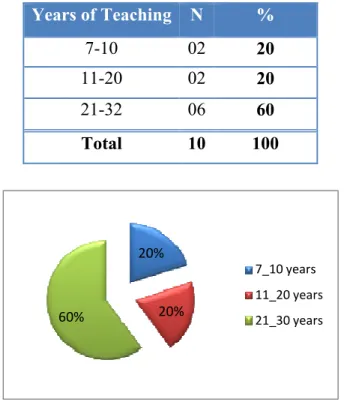
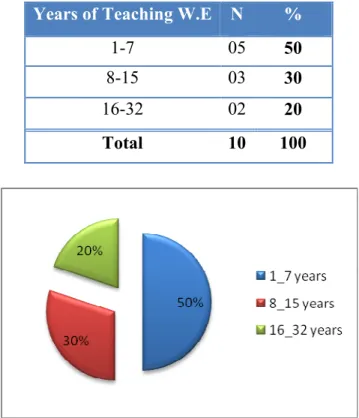
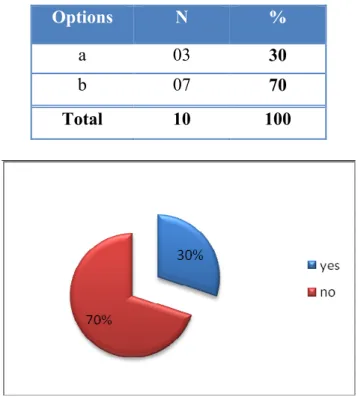
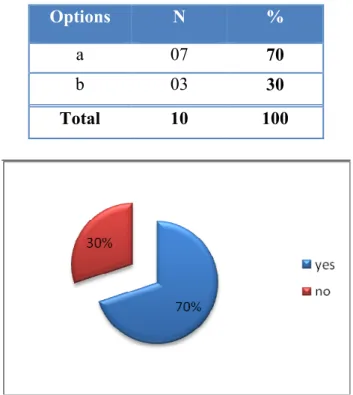
Documents relatifs
tdkp (Veprek et al. 2008 ) is a stand-alone software library based on a continuum descrip- tion to calculate strain, spontaneous and piezoelectric polarization and its
ploi publiées par l’Insee en partenariat avec la Dares [2], l’emploi salarié dans les secteurs marchands non agricoles (SMNA) s’est replié de 15 600 postes (-0,1 %), après
Dans la situation présente, élèves et enseignants ont des risques se retrouver dans une situation proche d’un mauvais MOOC : enseignement distant, équipement entre élèves très
A 293T cells were transfected with a vector encoding V5-tagged full-length SPATA2, along with empty vector (EV), a vector encoding FLAG-tagged HOIP wild-type (wt) or a vector encoding
Je n'avais jamais soupçonné, jamais même imaginé ne serait-ce que le temps d'un battement de coeur, qu'il puisse exister un lieu pour des gens tels que nous.... On
Aucune zone d’inhibition enregistrée dans les différents extraits de melia azedarach vis-à-vis les six souches bactériennes L’évaluation de l’activité
E : Euh c’est très difficile par exemple au niveau des ouvertures de compte, c’est très très difficile de chiffrer une image et enfin du retour sur
De plus, si notre Merkabah tourne plus vite que la vitesse de la lumière, cela nous fait disparaître du monde en 3D, avec les mêmes conséquences que celles que je vous ai
